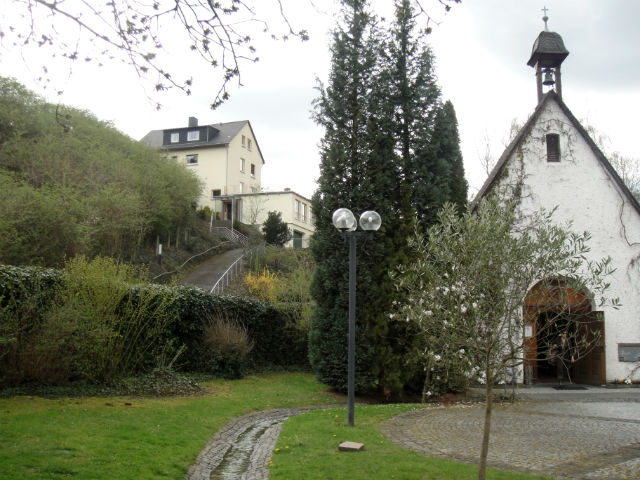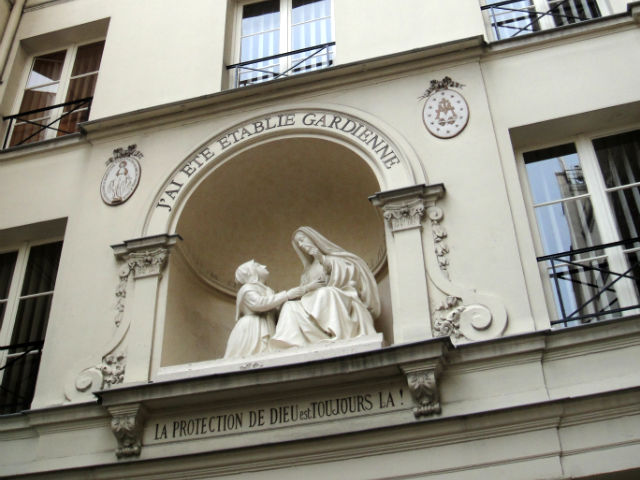Filtered By: Lifestyle
Lifestyle
Postcards from a pilgrimage, part I
By CARMELA G. LAPEÑA, GMA News
(First of two parts) When I told my daughter I would be going on a pilgrimage in Europe without her, I was worried that she’d feel bad. It's always a sad thing to be away from family, but it's even sadder not to be able to share one's journey with them. All pilgrimages are, after all, journeys toward self-discovery. And who best to share yourself with than those who are closest and dearest to you? So I brought my daughter along to the pre-trip orientation, hoping she’d feel better listening to the discussion about our schedule and all the places we would be visiting. "You're going to so many places! It looks nice, but I think it's tiring. Can you just take pictures and show me?" my eight-year-old asked. And so, a few weeks later, I boarded that long plane ride to Europe. Determined to keep my promise, I took photos of everything. At the end of the two-week trip, I had hundreds of photos, most of which were blurry shots of fields taken from a moving bus. 
After going through almost 1,500 files, I discovered I was able to get a few decent pictures of some of our pilgrimage stops. 1. Schoenstatt Original Shrine (Germany) A tiny church covered with vines, the Schoenstatt Original Shrine is found in Vallendar, Germany, where the International Schoenstatt Movement began. Founded by Father Joseph Kentenich, Schoenstatt is more than a place. "It is a way of life," Sister Mary Julia says. In October of 1914, Father Kentenich and a small group of students gathered in the little chapel, and sealed a covenant of love with Mary by consecrating themselves to Our Lady. They petitioned Our Lady to be especially active from the chapel as an educator, and to make it a place of grace from where people can find their way to God. Sister Mary Julia explains that pilgrims who visit Schoenstatt receive three graces: the grace of being at home, the grace of inner transformation, and the grace of apostolic zeal.  Pilgrims are just one of over 20 different communities that developed within the movement. Although Schoenstatt is not an apparition site, it’s an ideal place to begin a pilgrimage, as it is a place of grace. There are over 200 Schoenstatt Centers all over the world, each with an exact replica of the Original Shrine in Schoenstatt, which means "nice place." 2. Shrine of the "Virgin of the Poor" (Banneux, Belgium) In the small town of Banneux, a little girl named Mariette Beco had eight visions of the Virgin Mary in 1933. The Virgin Mary led the girl to a spring, instructing her to dip her hands in the water. "The spring is reserved for me," the Lady told her.
Pilgrims are just one of over 20 different communities that developed within the movement. Although Schoenstatt is not an apparition site, it’s an ideal place to begin a pilgrimage, as it is a place of grace. There are over 200 Schoenstatt Centers all over the world, each with an exact replica of the Original Shrine in Schoenstatt, which means "nice place." 2. Shrine of the "Virgin of the Poor" (Banneux, Belgium) In the small town of Banneux, a little girl named Mariette Beco had eight visions of the Virgin Mary in 1933. The Virgin Mary led the girl to a spring, instructing her to dip her hands in the water. "The spring is reserved for me," the Lady told her.  In the next apparitions, the Lady revealed more and more of herself— “I am the Virgin of the Poor”, then "I come to relieve suffering”. She advised the child to “pray a lot.” A chapel had since been built, followed by other smaller chapels, a hospital for the sick, The Way of the Cross, and statues of Saints along a forest pathway. The other pilgrims and I dipped our hands in the spring, as the child Mariette did several years ago. 3. Lourdes
In the next apparitions, the Lady revealed more and more of herself— “I am the Virgin of the Poor”, then "I come to relieve suffering”. She advised the child to “pray a lot.” A chapel had since been built, followed by other smaller chapels, a hospital for the sick, The Way of the Cross, and statues of Saints along a forest pathway. The other pilgrims and I dipped our hands in the spring, as the child Mariette did several years ago. 3. Lourdes 
In 1858, the Blessed Virgin appeared to the then 14-year-old Bernadette Soubirous. In the Grotto of Massabielle, the Lady identified herself as the Immaculate Conception. She revealed a flowing spring, and told Bernadette to drink and wash herself with the water. Pilgrims visiting Lourdes fill their containers with the water, and some immerse themselves in the Baths' 12-degree-Celsius water. Every night, pilgrims of all nations gather at the Rosary Square, praying in their native languages. There are several places of worship in Lourdes, including an Underground Basilica and the Way of the Cross on the Espelugues Hill. 4. Chapel of Our Lady of the Miraculous Medal A grotto in the heart of Paris, the Church of the Miraculous Medal is a Marian sanctuary in the city's 7th district.  In 1830, a young novice of the Daughters of Charity had a vision of the Blessed Virgin standing on a half-globe, a small golden globe in her hands and a serpent crushed beneath her feet. Rays of light came from the Blessed Virgin's hands, and Sister Catherine Laboure heard a voice saying "These rays are symbols of graces that Mary obtains for people." An oval formed around the apparition, and a gold-lettered invocation was revealed to the Saint: "Oh Mary conceived without sin, pray for us who have recourse to you." St. Catherine saw on the reverse side of the picture, the letter M with a little cross, and below it the Sacred Hearts of Jesus and Mary. "Have a medal made on this model. Those who wear it with confidence will receive great graces," the voice said. Twenty-thousand people died during a cholera epidemic in Paris in 1832. The Daughters of Charity began to distribute the first 2,000 medals, made at the request of St. Catherine's confessor Father Aladel. The number of cures multiplied, as did requests for the medal, which the people believed was miraculous. By the time St. Catherine died in 1876, more than a billion medals were made. St. Catherine's body is in a reliquary in the Chapel, a sanctuary for Marian pilgrims. 5. The Sacred Heart Basilica (Paray-le-Monial)
In 1830, a young novice of the Daughters of Charity had a vision of the Blessed Virgin standing on a half-globe, a small golden globe in her hands and a serpent crushed beneath her feet. Rays of light came from the Blessed Virgin's hands, and Sister Catherine Laboure heard a voice saying "These rays are symbols of graces that Mary obtains for people." An oval formed around the apparition, and a gold-lettered invocation was revealed to the Saint: "Oh Mary conceived without sin, pray for us who have recourse to you." St. Catherine saw on the reverse side of the picture, the letter M with a little cross, and below it the Sacred Hearts of Jesus and Mary. "Have a medal made on this model. Those who wear it with confidence will receive great graces," the voice said. Twenty-thousand people died during a cholera epidemic in Paris in 1832. The Daughters of Charity began to distribute the first 2,000 medals, made at the request of St. Catherine's confessor Father Aladel. The number of cures multiplied, as did requests for the medal, which the people believed was miraculous. By the time St. Catherine died in 1876, more than a billion medals were made. St. Catherine's body is in a reliquary in the Chapel, a sanctuary for Marian pilgrims. 5. The Sacred Heart Basilica (Paray-le-Monial)  The basilica is dedicated to the Sacred Heart, in remembrance of Christ's apparitions to Saint Margaret-Mary Alacoque. Since the apparitions in the 17th century, many pilgrims made the journey to Paray-le-Monial, which has been classified as a Historic Monument since 1846. It was built in the 12th century under the direction of Hugues of Semur, the sixth abbot of Cluny. The priory church of Paray-le-Monial was declared a minor basilica by Pope Pius IX in 1875. In the 19th century, it was restored by Eugene Millet, a disciple of the French architect Viollet-leDuc. An architectural masterpiece, the Sacred Heart Basilica features Romanesque art and rich, ornate sculptures, like the rosette frieze on one of the doors. A Byzantine-inspired painting of the Pantocrator (Christ in Glory) hangs in the choir, which features a chequered billet moulding. Outside the church are medieval style cloister gardens that are conducive to contemplation, if not for the biting cold. Hopping from one holy site to another definitely took a lot from me, not to mention missing my daughter. But when I got back, our bonding time was made even more special because of all the pictures and the stories behind them. (to be continued) — AC/TJD, GMA News
The basilica is dedicated to the Sacred Heart, in remembrance of Christ's apparitions to Saint Margaret-Mary Alacoque. Since the apparitions in the 17th century, many pilgrims made the journey to Paray-le-Monial, which has been classified as a Historic Monument since 1846. It was built in the 12th century under the direction of Hugues of Semur, the sixth abbot of Cluny. The priory church of Paray-le-Monial was declared a minor basilica by Pope Pius IX in 1875. In the 19th century, it was restored by Eugene Millet, a disciple of the French architect Viollet-leDuc. An architectural masterpiece, the Sacred Heart Basilica features Romanesque art and rich, ornate sculptures, like the rosette frieze on one of the doors. A Byzantine-inspired painting of the Pantocrator (Christ in Glory) hangs in the choir, which features a chequered billet moulding. Outside the church are medieval style cloister gardens that are conducive to contemplation, if not for the biting cold. Hopping from one holy site to another definitely took a lot from me, not to mention missing my daughter. But when I got back, our bonding time was made even more special because of all the pictures and the stories behind them. (to be continued) — AC/TJD, GMA News

Pilgrims gather at the Grotto of Massabielle.

The Schoenstatt Original Shrine in Germany

The spring at the Shrine of the Virgin of the Poor

The blessed Virgin Mary is said to have revealed a flowing spring here. Today, pilgrims line up to fill their containers with the holy water.

Statue of St. Catherine and the Blessed Virgin outside the Chapel of Our Lady of the Miraculous Medal

Since the apparitions in the 17th century, many pilgrims made the journey to Paray-le-Monial, which has been classified as a Historic Monument since 1846.
Tags: paris, pilgrimagesites
More Videos
Most Popular



